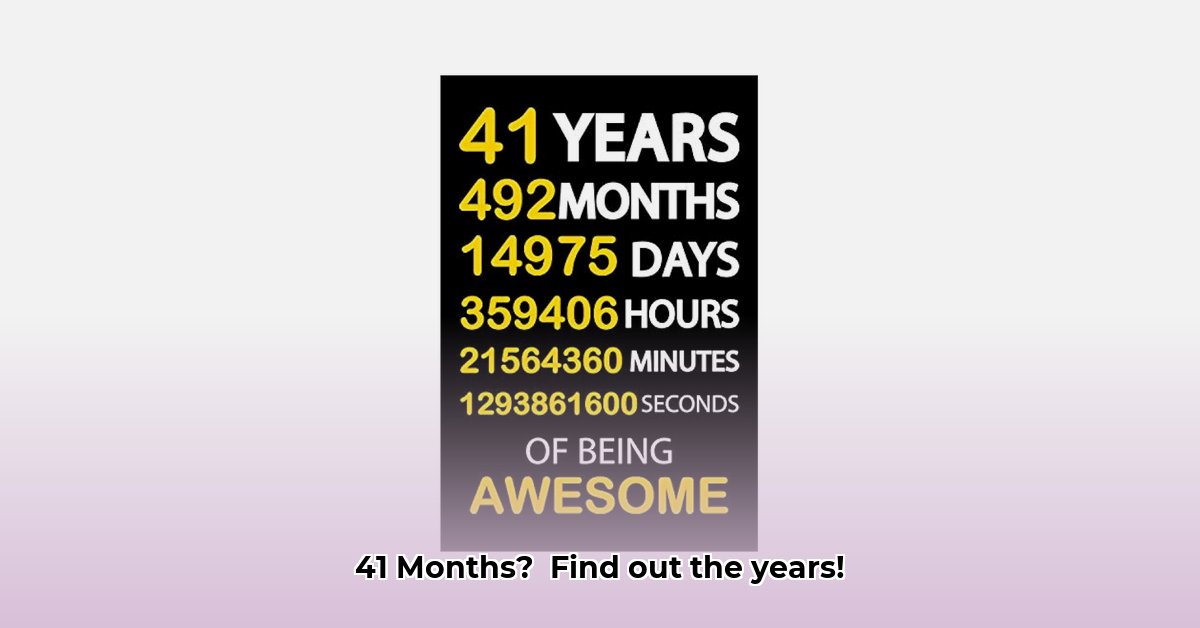
Ever wondered how many years are in 41 months? It might seem like a simple division problem—41 divided by 12—but the reality is more nuanced. The uneven lengths of months and the occasional leap year introduce complexities that affect the accuracy of a simple calculation. This guide will provide clear, step-by-step methods for converting months to years, ensuring you achieve the most accurate result possible.
The Quick and Easy (But Imperfect) Method
The quickest way to estimate the number of years in 41 months is to divide 41 by 12: 41 months / 12 months/year ≈ 3.42 years. This provides a rough approximation, but it significantly underestimates the precision needed in many applications. This simplification ignores the varying lengths of months (some have 30 days, others 31) and the existence of leap years, which add an extra day to February every four years (with some exceptions). Think of it like trying to measure a winding road with a straight ruler; you'll get a number, but it won't be perfectly accurate.
A More Precise Approach: Accounting for Full Years and Remaining Months
For a more accurate conversion, we address the issue of uneven months by first calculating the number of full years contained within 41 months.
Identify Full Years: Divide 41 months by 12 months/year: 41 ÷ 12 = 3 years with a remainder.
Calculate Remaining Months: The remainder represents the number of months left over. In this case, 41 - (3 * 12) = 5 months.
Express the Result: Therefore, 41 months is equivalent to 3 years and 5 months. This method is significantly more accurate than simple division, providing a clearer representation of the time period.
Leap Years: Adding Another Layer of Complexity
Leap years introduce an additional layer of complexity. The presence of a leap year within the 41-month period will subtly affect the total duration. A leap year adds an extra day to February, making the total number of days in the year 366 instead of 365. To achieve peak accuracy, the precise start date of the 41-month period is needed to determine whether a leap year is included. For instance, a 41-month period starting in February of a leap year will be slightly longer than one beginning in March of the same year.
Practical Applications: Where Precision Matters
The need for accurate time conversions extends far beyond simple curiosity. Many fields rely on precise calculations to ensure accuracy and avoid potentially costly errors.
Finance: Accurate time conversions are critical in calculating interest accrual, loan amortization schedules, and investment returns. Even minor inaccuracies can compound over time, leading to significant financial discrepancies.
Project Management: Project timelines often rely on precise time calculations to ensure deadlines are met and resources are allocated effectively. Inaccurate estimations can lead to delays, cost overruns, and project failure.
Legal Contracts: Contracts with specified time durations (e.g., leases, employment agreements) should use accurate conversions to guarantee clarity and prevent future disputes.
Comparing Different Methods: A Summary
Here’s a concise comparison of the methods discussed:
| Method | Accuracy | Complexity | When to Use |
|---|---|---|---|
| Simple Division (41 months / 12 months) | Low | Very Low | Rough estimations only |
| Full Years and Remaining Months Method | Medium | Low | When relative accuracy is sufficient |
| Method Accounting for Leap Years | High | Medium | Situations requiring greater precision; necessitates knowing the start date |
The optimal approach depends on the required level of accuracy. For a quick approximation, simple division may suffice. However, for applications demanding higher precision, the more detailed methods are crucial.
Conclusion: The Importance of Accuracy in Time Conversion
Converting months to years might seem straightforward, but the reality is more nuanced. By understanding the complexities of varying month lengths and leap years, you can choose the appropriate method to ensure accuracy in your calculations. The consequences of inaccurate time conversions can be significant in various fields, emphasizing the importance of choosing the most suitable method for your specific needs. Remember, when accuracy matters, consider the detailed methods; when a rough estimate suffices, a quick calculation is acceptable.